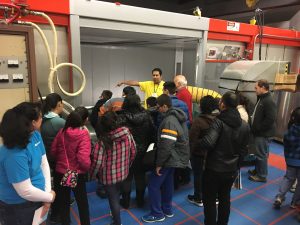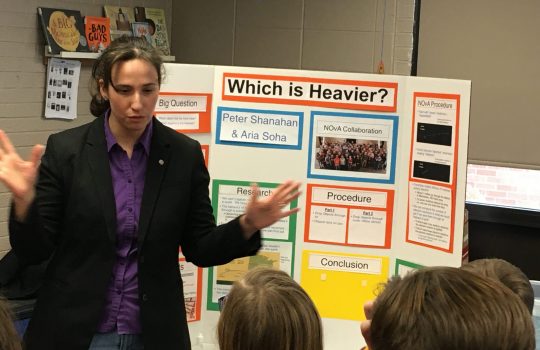
Fermilab postdoc Minerba Betancourt addresses the crowd in Fermilab’s first Spanish-language Ask-a-Scientist event. Photo: Jesus Orduna
On Sunday, March 12, Fermilab hosted “Pregúntale a un Científico,” which was attended by almost 100 curious neighbors of all ages.
The Spanish-language offering was part of the laboratory’s long-standing Ask-a-Scientist program. Although the program has been around in its current form for 15 years, this is the first time an event has been held in a language other than English.
Over the course of three hours, the attendees heard a lecture about neutrinos and Fermilab’s role in studying them by Minerba Betancourt, a Fermilab postdoctoral researcher. They were also given a tour of different areas of Fermilab, including the Main Control Room, Ramsey Auditorium and the linear accelerator corridor.
Ask-a-Scientist is held on the first Sunday of every month and features a lecture, tour of the facilities and opportunity to ask Fermilab physicists any physics question you want.
Edgar Valencia, a postdoctoral researcher from The College of William and Mary working on the MINERvA experiment who led one of the tours, said that the tour helped dispel myths that Fermilab was a closed-off and secretive place.
“Events like these are important to show the community that all we’re really doing is science,” he said.

Edgar Valencia, a postdoc on the MINERvA experiment, explains how the Fermilab linear accelerator works. Photo: Dan Garisto
“There was interest in doing it in Spanish, so we got people together and set it up,” said Peter Garbincius, who founded and heads the Ask-A-Scientist program. “We had no idea what to expect though.”
Much of the event is the same as its English-language counterpart, but there are still a few tricky phrasings to work out.
“Some things are hard to translate to Spanish,” Valencia said.
His advice? Avoid technical English and use common words if you can. Talking about muons or electrons? Try “las partículas cargadas,” which literally translates as “charged particles.”
Daniel Laguna, a visiting high school student, said that what he found most interesting was the collaboration between physicists.
“I didn’t know about the worldwide collaboration, with people from Fermilab working with CERN and stuff, to solve these problems,” he said.
Valencia said that when people come here and take part in the tour, they want to know more.
“I was only expecting 10 or 20 people, so I was really surprised at the numbers and the receptiveness,” he said. “I told them to come back and visit the Lederman Science Center.”
According to Garbincius, the event was so successful that Fermilab is considering scheduling Pregúntale a un Cientifíco on a regular basis.


